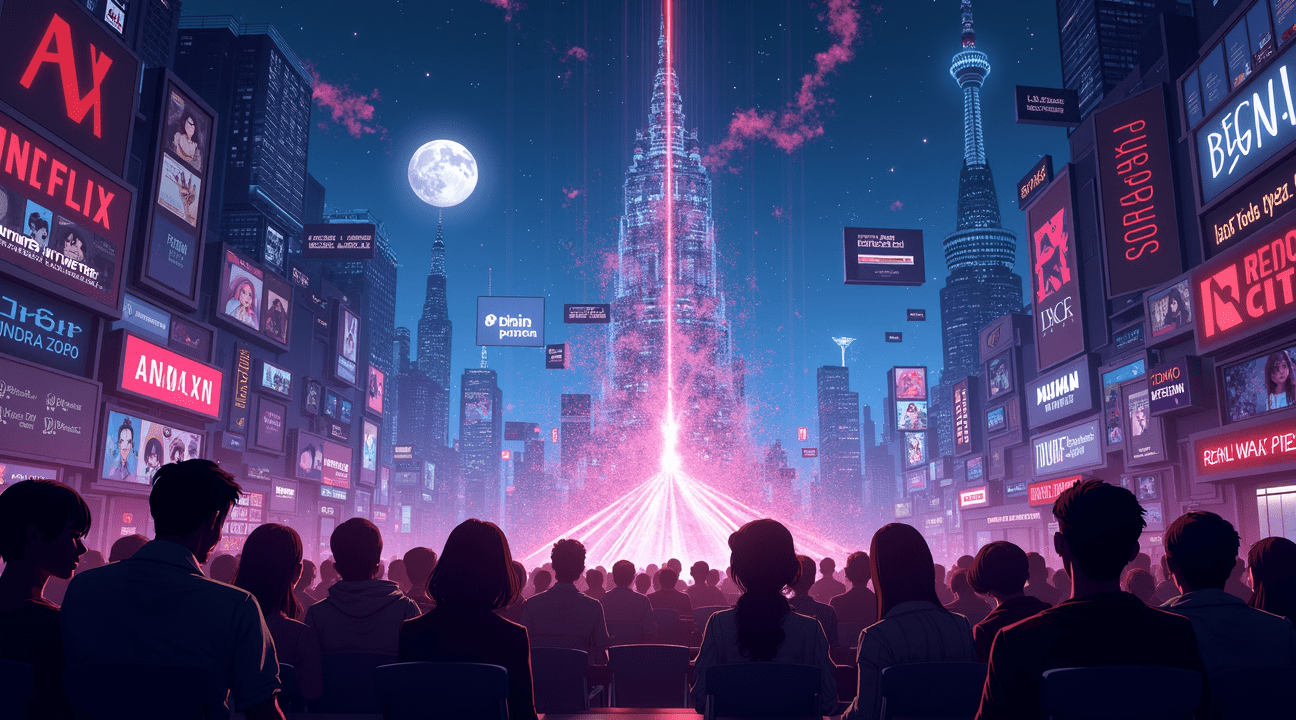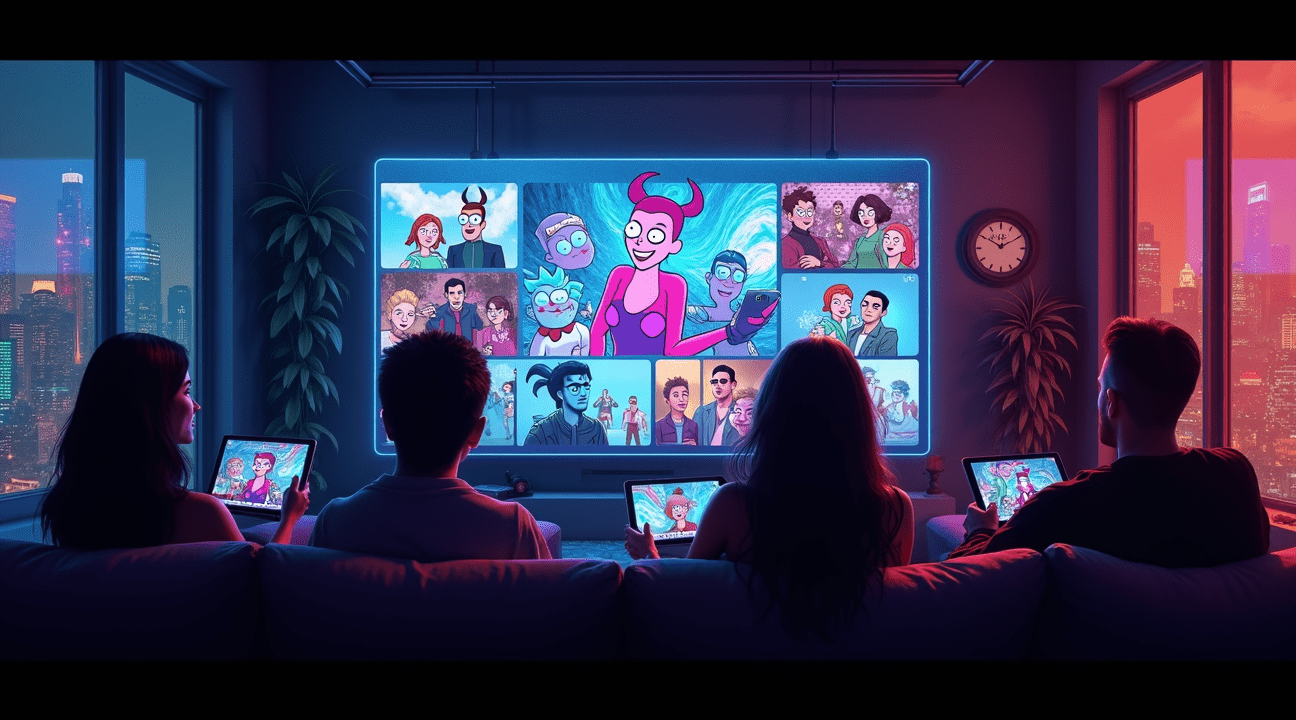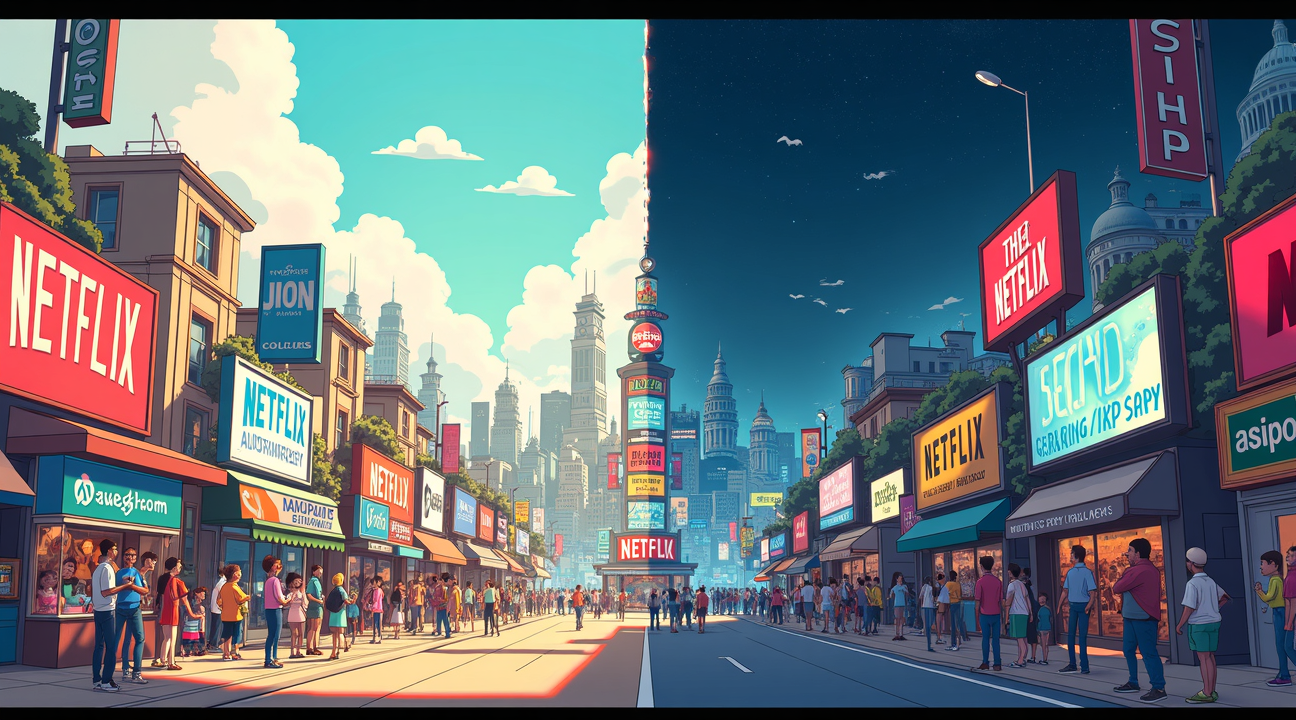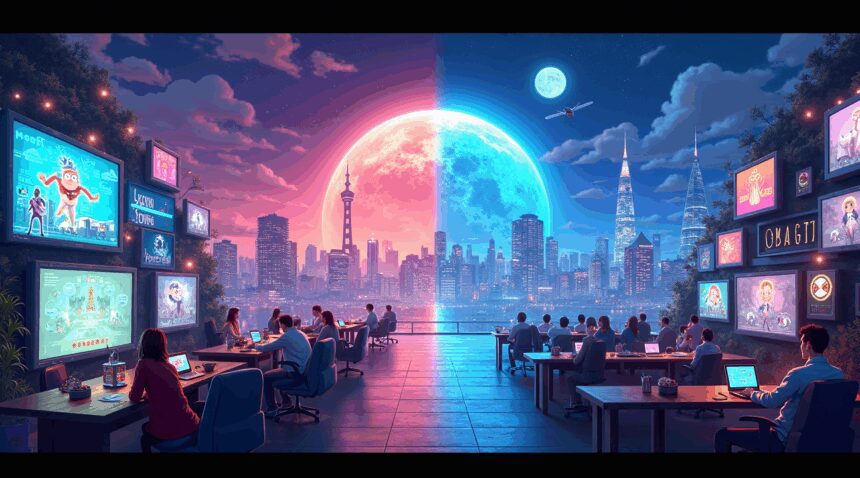The adult animation industry has experienced unprecedented growth, with the global market expanding from USD 4.5 billion in 2023 to projected values between USD 9.8-11.2 billion by 2032–2033.
Streaming platforms such as Netflix, Amazon Prime, and Hulu have fundamentally transformed how mature animated content reaches audiences. By breaking traditional distribution barriers and investing heavily in original programming, these platforms are fueling a creative surge in adult animation, emphasizing complex subjects ranging from social commentary to psychological intricacy.
Key Takeaways
- Explosive Market Growth: The adult animation sector is experiencing a compound annual growth rate of 9.2% to 10.7%. This growth is primarily driven by streaming platform investments and shifting audience preferences toward mature animated storytelling.
- Streaming Revolution: Digital platforms have removed traditional broadcast limitations, allowing niche and avant-garde content to find global audiences. These platforms also rely on data-driven insights to greenlight experimental projects that traditional television often avoids.
- Sophisticated Storytelling: Modern adult animation explores deep, complex themes such as existential philosophy, political satire, and psychological trauma. Creators push beyond simplistic cartoon tropes to deliver layered narratives and rich character arcs.
- Diverse Representation: Contemporary adult animation features increased representation of LGBTQ+, racial, and cultural diversity. Importantly, these stories incorporate such diversity through meaningful, character-driven narratives rather than superficial tokenism.
- Industry Expansion: The influence of animation is spreading into sectors like education, marketing, and business communication. Tools like Blender are democratizing production, empowering independent creators to compete head-to-head with major studios.
The 9.8 Billion Dollar Animation Revolution Transforming Entertainment
I’ve witnessed an unprecedented shift in how the industry views animated content, and the numbers tell a compelling story. The global adult animation market reached approximately USD 4.5 billion in 2023, setting the stage for explosive growth that financial analysts predict will catapult the sector to between USD 9.8 billion and USD 11.2 billion by 2032–2033. This represents a compound annual growth rate of 9.2% to 10.7%, signaling that mature animated content has evolved from niche programming to a mainstream entertainment powerhouse.
Regional Powerhouses and Shifting Market Dynamics
North America currently dominates this lucrative market, powered by established production companies and sustained consumer demand for sophisticated animated storytelling. Major studios in Los Angeles and New York continue to push creative boundaries, producing content that resonates with adult audiences seeking more than traditional children’s fare. However, Asia Pacific emerges as a formidable competitor, with industry experts predicting this region could surpass North America by 2026. Countries like Japan, South Korea, and China have ramped up production capabilities while developing unique storytelling approaches that appeal to global audiences.
The streaming revolution fundamentally changed how adults consume animated content. Netflix, Amazon Prime, and Hulu recognized early that adult animation offered tremendous profit potential, investing heavily in original programming that features mature themes, complex narratives, and sophisticated humor. Shows like Rick and Morty demonstrate how platforms leverage popular franchises to maintain subscriber engagement while attracting new viewers through viral marketing and social media buzz.
These platforms didn’t just invest money—they transformed viewing habits through data-driven content recommendations and binge-watching promotion strategies. Algorithm-based suggestions encourage viewers to discover new animated series, while entire seasons released simultaneously create viewing marathons that boost engagement metrics. Netflix’s animated offerings exemplify this approach, combining nostalgic properties with fresh storytelling techniques that appeal to diverse demographic segments.
The COVID-19 pandemic accelerated trends already gaining momentum, as homebound audiences sought entertainment that offered both escapism and intellectual stimulation. Adult animation provided the perfect solution, combining visual creativity with storytelling depth that satisfied viewers craving content beyond reality television and news cycles. Production companies adapted quickly to remote workflows, maintaining output levels while audiences consumed animated content at record rates.
Streaming platforms capitalized on this surge by expanding their animation catalogs and promoting classic animated series alongside contemporary productions. This strategy broadened appeal across age groups while establishing animation as legitimate prime-time viewing rather than afternoon children’s programming.
Contemporary adult animation embraces themes previously considered taboo for animated content, including:
- Social commentary
- Political satire
- Psychological complexity
Shows tackle subjects ranging from workplace dysfunction to existential philosophy, proving that animation serves as an effective medium for exploring mature concepts. Harley Quinn’s renewal demonstrates how female-centric animated content finds dedicated audiences, while productions like Velma reimagine classic characters through contemporary lenses.
The financial success of adult animation stems partially from lower production costs compared to live-action equivalents, combined with higher profit margins through merchandise, licensing, and international distribution deals. Animated characters don’t require expensive celebrity contracts or location shoots, yet they generate comparable audience engagement and revenue streams. Studios leverage these economic advantages to experiment with unconventional storytelling approaches and niche content that might prove too risky for live-action productions.
International content distribution has expanded dramatically, with animated series crossing cultural boundaries more easily than live-action programming. Animation transcends language barriers through visual storytelling, while dubbing and subtitling required for global distribution often cost less than producing region-specific live-action content. Even experimental projects like Sausage Party’s animated series find international audiences willing to embrace unconventional humor and storytelling approaches that push creative boundaries.
Technological advances in animation software and cloud-based collaboration tools have democratized content creation, enabling smaller studios and independent creators to compete with established production houses. This increased competition drives innovation while expanding the variety of content available to adult audiences seeking alternatives to traditional network programming.
https://www.youtube.com/watch?v=zEfcfDcvypk

How Streaming Giants Are Reshaping Adult Animation Distribution
Streaming services have fundamentally transformed how adult animation reaches audiences, breaking down traditional barriers that once limited distribution channels. I observe that platforms like Netflix, Amazon Prime, and Hulu now serve as the primary drivers of growth in this sector, moving beyond the constraints of broadcast television schedules and cable network restrictions.
Global Reach and Niche Targeting
Digital distribution through streaming platforms enables adult animation to find its intended audience regardless of geographical boundaries. Unlike traditional television broadcasts that required specific time slots and regional licensing deals, on-demand content allows viewers to discover shows like Rick and Morty or explore experimental formats at their convenience. This accessibility has proven particularly beneficial for content that pushes creative boundaries, as streaming services can cater to specific demographics without worrying about broad appeal during primetime hours.
Streaming giants have also demonstrated their commitment to adult animation by investing heavily in original programming. Netflix has expanded its catalog with diverse offerings, while Amazon Prime and Hulu continue developing exclusive content that wouldn’t traditionally find space on network television. These platforms recognize that adult animation appeals to a sophisticated audience willing to pay for premium content, making it a profitable investment strategy.
Technological Innovation Driving Quality
Technological advancements have significantly improved both production capabilities and content accessibility. Modern 3D animation tools have become more affordable and user-friendly, allowing creators to produce high-quality content without massive studio budgets. This democratization of animation technology has led to an explosion of independent creators who can now compete with established studios.
High-speed internet availability has eliminated many distribution bottlenecks that previously plagued home video releases. Viewers no longer need to wait for physical media or rely on specific broadcast schedules. Instead, they can stream content in high definition immediately upon release, creating a more responsive relationship between creators and audiences.
The shift from traditional TV series distribution models has also changed how content gets greenlit and funded. Streaming platforms can analyze viewer data more precisely than television networks, allowing them to make informed decisions about which projects to support. Shows like Harley Quinn have found success through this data-driven approach, proving that adult animation can thrive when properly matched with its target audience.
This digital-first approach has created new opportunities for experimental content that might not have survived traditional television metrics. Streaming services can afford to take creative risks because they’re building comprehensive libraries rather than competing for individual time slots.

From Simple Cartoons to Complex Narratives: What Makes Adult Animation Different
Adult animation has evolved far beyond the simple cartoon format that once dominated children’s television. Today’s animated content for mature audiences tackles sophisticated themes that would never appear in traditional kids’ shows. These productions explore complex relationship dynamics, political commentary, graphic violence, and dark humor with an unflinching approach that resonates with viewers seeking substantive entertainment.
Mature Themes and Sophisticated Storytelling
The primary distinction between adult animation and children’s cartoons lies in thematic depth and narrative complexity. Shows like Rick and Morty present existential philosophy alongside crude humor, while productions such as Harley Quinn examine psychological trauma through superhero narratives. Adult animated content doesn’t shy away from controversial topics or uncomfortable realities that define the human experience.
Characters in mature animation face genuine consequences for their actions, unlike their children’s counterparts who often reset to baseline by episode’s end. This storytelling approach creates emotional investment and allows for character development that spans multiple seasons. Writers craft multi-layered plots that reference current events, social issues, and cultural phenomena, ensuring content remains relevant to adult audiences.
The demographic for adult animation primarily spans ages 18 to 44, with distinct segments responding to different content styles:
- 18-24: gravitates toward irreverent comedy and boundary-pushing humor
- 25-34: appreciates satirical takes on workplace culture and relationship struggles
- 35-44: favors content with nostalgic elements combined with mature perspectives on family dynamics and social responsibility
Artistic Innovation and Genre Diversity
Adult animation employs diverse artistic styles that enhance storytelling rather than simply appealing to young viewers. Productions utilize 2D traditional animation, cutting-edge 3D rendering, and hybrid formats that blend multiple techniques within single episodes. This artistic flexibility allows creators to match visual style with narrative tone, creating immersive experiences that complement mature content.
Genre diversity in adult animation has expanded significantly, encompassing the following categories:
- Comedy series that blend social satire with character-driven humor
- Drama productions exploring serious themes through animated storytelling
- Action shows featuring realistic consequences and complex moral dilemmas
- Horror content that pushes visual boundaries impossible in live-action
- Science fiction narratives that examine philosophical and technological concepts
The streaming revolution has accelerated content diversity, with platforms investing heavily in original adult animated programming. Netflix announces new projects regularly, while other services compete by developing unique animated content that targets specific adult demographics. This competition drives innovation and ensures continuous evolution in storytelling techniques.
Projects like the Sausage Party animated series demonstrate how successful films can expand into television formats, while shows like Velma reimagine classic characters for contemporary adult audiences. Anime and classics continue finding new audiences through streaming platforms that recognize the growing demand for sophisticated animated content.
Adult animation’s success stems from its willingness to address real-world issues through the unique lens that animation provides. This medium offers creators complete creative control over visual elements while maintaining relatability through voice performances and character development. The result is content that speaks directly to adult experiences while utilizing animation’s limitless creative possibilities.
The continued growth in adult animation reflects broader changes in media consumption habits, with audiences increasingly seeking content that challenges conventional storytelling boundaries while providing entertainment value that matches their intellectual and emotional maturity levels.

Breaking Barriers: How Modern Adult Toons Address Diversity and Representation
I’ve watched adult animation transform dramatically over the past decade, with creators making deliberate choices to include characters who reflect the full spectrum of human experience. Shows like Harley Quinn and Rick and Morty have moved beyond token representation, creating complex characters whose identities encompass LGBTQ+, racial, and cultural dimensions without reducing them to single defining traits.
This shift represents more than superficial changes in character design. I see creators actively working to develop storylines that honor the authentic experiences of marginalized communities while avoiding the pitfalls that plagued earlier animated content. Characters now possess depth that extends beyond their identity markers, allowing viewers to connect with fully realized individuals rather than walking stereotypes.
Three Distinct Approaches to Identity in Animation
Contemporary adult animation employs various storytelling strategies when incorporating diverse characters and themes:
- Issue-focused narratives place identity at the center of specific episodes or story arcs, directly addressing topics like coming out, discrimination, or cultural heritage.
- Incidental representation allows diverse characters to exist within stories where their identity informs their perspective but doesn’t dominate the plot.
- Integrated approaches weave identity naturally throughout character development, making it one of many layers that comprise a complete personality.
Each method serves different storytelling purposes, and I’ve noticed the most successful shows blend all three approaches rather than relying on just one technique.
The animation medium itself offers unique advantages for representation. Artists can create characters without the physical limitations of live-action casting, enabling stories about fantastical beings who still grapple with real-world identity issues. Shows like BoJack Horseman demonstrated how anthropomorphic characters could explore depression, sexuality, and trauma in ways that felt both accessible and profound.
However, challenges persist within this progressive landscape. I still encounter animated content that treats diverse characters as exotic curiosities rather than authentic individuals. Some creators fall into the trap of making identity the sole defining characteristic of their diverse characters, creating flat portrayals that serve plot devices more than genuine representation.
The most effective adult animations I’ve analyzed understand that representation works best when it feels organic rather than performative. Characters should possess flaws, desires, and contradictions that extend beyond their identity group membership. Recent anime series have particularly excelled at this balance, creating characters whose cultural backgrounds inform their worldview without overwhelming their individual personality traits.
Animation studios have also recognized the importance of diverse creative teams behind the camera. I’ve observed that shows with writers, directors, and voice actors from various backgrounds tend to produce more authentic representation. These creators bring lived experiences that prevent the storytelling from relying solely on research or assumptions about communities they don’t personally understand.
The financial success of inclusive animated content has encouraged networks and streaming platforms to greenlight more diverse projects. Netflix’s expanding anime catalog reflects this trend, featuring stories from creators worldwide who bring unique cultural perspectives to their animated work.
Audience reception has largely embraced these changes, particularly among younger demographics who expect to see themselves reflected in media. I’ve noticed that viewers respond positively to authentic representation while quickly identifying and critiquing tokenism or stereotypical portrayals.
The future of diverse adult animation looks promising, with new voices entering the industry and established creators continuing to push boundaries. Upcoming animated series demonstrate that studios are willing to take creative risks with unconventional narratives that center previously marginalized perspectives.
Success in this area requires ongoing commitment rather than one-time gestures. I believe the most impactful adult animations will continue expanding representation while maintaining the irreverent humor and complex storytelling that defines the genre. The key lies in treating diversity as a natural part of storytelling rather than a special feature to be highlighted or compartmentalized.
The Powerhouse Studios and Shows Defining Adult Animation Today
I’ve witnessed tremendous growth in adult animation over the past decade, with several studios and series establishing themselves as industry leaders. These productions have redefined what animated content can achieve when targeting mature audiences.
Netflix Animation has emerged as a dominant force, producing standout series like BoJack Horseman, which masterfully explored depression, addiction, and celebrity culture through the lens of a washed-up horse actor. The platform’s Big Mouth tackles adolescence with unprecedented honesty, while Love, Death & Robots showcases anthology storytelling with cutting-edge animation techniques. F is for Family rounds out Netflix’s impressive portfolio by examining dysfunctional family dynamics through a 1970s setting.
Studios Driving Innovation Forward
Several key production houses are pushing creative boundaries in adult animation:
- Netflix Animation continues expanding its original content library with diverse storytelling approaches
- Adult Swim and Cartoon Network Studios maintain their reputation for experimental, boundary-pushing content
- Fox Television Animation leverages decades of experience with long-running series
- DreamWorks Animation Television brings theatrical-quality animation to television formats
- FX Networks supports creator-driven projects that prioritize artistic vision
Adult Swim remains synonymous with innovative adult animation, particularly through Rick and Morty, which combines science fiction with dark comedy and philosophical themes. The network’s willingness to experiment with unconventional formats has influenced countless other productions.
FX has carved its niche with series like Archer, which blends spy fiction with workplace comedy in distinctive animation style. The network’s approach demonstrates how traditional live-action networks can successfully venture into animation.
These studios recognize that adult audiences crave sophisticated storytelling that animation uniquely enables. They’re investing in diverse voices and experimental techniques, moving far beyond the assumption that cartoons are exclusively for children.
The success of these series proves that adult animation can tackle complex subjects while maintaining entertainment value. From psychological drama to science fiction comedy, modern productions showcase animation’s versatility as a storytelling medium. Each studio brings distinct strengths, whether Netflix’s data-driven content development, Adult Swim’s countercultural sensibility, or FX’s creator-focused approach.
This landscape continues evolving as streaming platforms compete for exclusive content and traditional networks adapt to changing viewing habits. The quality and variety of current adult animation suggests this golden age will continue expanding.
Beyond Entertainment: Animation’s Expanding Role Across Industries
I’ve watched animation transform from a niche entertainment medium into a powerhouse driving innovation across multiple industries. The numbers tell a compelling story about this evolution. The global animation market stands poised to reach USD 462 billion in 2025, with projections showing explosive growth to USD 895 billion by 2034.
This expansion reflects animation’s versatility beyond traditional entertainment venues. Educational institutions now leverage animated content to simplify complex concepts and engage students more effectively. Marketing departments have discovered that animated videos capture audience attention 300% longer than static content, making them invaluable for digital distribution strategies.
Business communication has embraced animation as well, with companies using animated presentations and explainer videos to convey ideas that text alone can’t express. This shift parallels the rise of on-demand content consumption, where viewers expect engaging, visual storytelling across all platforms.
Tools Driving Professional Animation Growth
The democratization of professional-grade tools has accelerated this industry expansion. Blender, once considered a specialized 3D animation program, has gained mainstream adoption across various sectors. Current data indicates that approximately 50% of game developers will integrate Blender into their workflows by 2025.
Gaming studios particularly value Blender’s versatility for creating assets, environments, and character models. Its open-source nature and powerful capabilities make it an attractive alternative to expensive proprietary software. I’ve observed independent creators and small studios leveraging Blender to produce content that rivals major studio productions.
Streaming platforms have also embraced this trend, commissioning animated series that push creative boundaries. Shows like Rick and Morty demonstrate how adult-oriented animation can capture massive audiences, while Harley Quinn’s renewal proves the commercial viability of mature animated content.
The convergence of improved technology, accessible tools, and growing market demand has created opportunities for animators across industries. Content creators can now distribute their work directly to global audiences through streaming platforms, bypassing traditional gatekeepers. This shift has enabled diverse voices to enter the animation space, contributing to the medium’s rapid expansion beyond entertainment into education, marketing, and professional communication sectors.
Sources:
DataIntelo, “Adult Animation Market Report | Global Forecast From 2025 to 2033”
Business Research Insights, “Adult Animation Market Size, Share & Report [2033]”
Kasra Design, “Top 15 Animation Industry Statistics in 2025 (with Graphs)”
Educational Voice, “Animation Adoption Statistics: Trends and Insights”
MediaSmarts, “Representation of Diversity in Media – Overview”


